In this film, trainer Elsa Sinclair asks the question: If a wild mustang were given the choice – without ropes, halters, whips, food rewards, etc. – of whether to be ridden, or not, would the horse let Elsa ride her?
“What if horses were given a choice? Would they carry us on their backs if they really had a choice? Would they want us to ride?”
Elsa gave herself one year to determine the answer to this question.
Taming Wild has a lovely pacing to it. Elsa’s peaceful voice narrates the story and the film footage illustrates beautifully what she’s talking about. The original music by Cora Rose is also a lovely accompaniment.
The beginning…
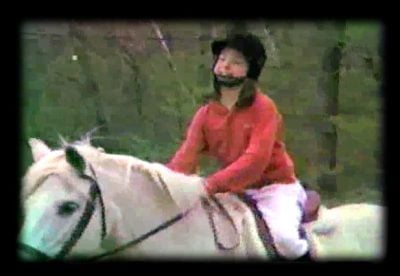
Personally, I resonated strongly with the early scenes of Elsa with her first Arab/Welsh pony. The quintessential dream horse who was ‘willing to lend Elsa his wings’. I too, had an amazing soulmate first horse who was my best friend, my spiritual guide, and my mentor. So when Elsa says:
“I feel like I’ve spent my whole life trying to re-create that feeling”
I know what she’s talking about! Although in my case, I’m really not sure if what I had with my Morgan/Arab mare, Dobbin, is even possible. Because Dobbin was like a mother to me – she literally kept me alive as I was unmoored and very much alone. And I am simply not that same person now. So why would I attract, or need, or resonate with that same kind of equine?
The journey I’m on with my horses now is about so much more than my safety and survival. They are challenging me to grow, to expand – they are calling me to mastery in so many areas. But yes, there has definitely been a ‘letting go’ aspect to this process. It would be like a boy who had the most perfect, amazing mother. And now that he’s a man, he’s looking for that same perfect, amazing mother – except that really, he does not need another mother, he needs a wife (or partner)!
Anyway, I digress… and I’m not saying Elsa had the same relationship with her first pony as I did with mine. In fact, I think they were likely very different. Elsa seems to have had more of a partnership with her pony, where he enabled her to run faster, jump higher, and go places she couldn’t go on her own two little human legs.
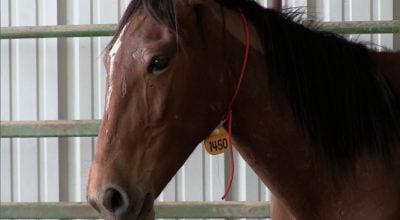
Regardless, it’s a nice set-up to the premise of the film and provides the underpinning for Elsa’s quest to explore whether she can train a mustang using no tools whatsoever – not even food rewards – only body language.
I like Elsa’s emphasis throughout the film on watching for the mustang, Myrnah’s, cues – the way she pays attention to Myrnah’s breath and uses it as an indicator of bracing, or withholding, or resistance.
As a professional horse trainer who has learned dozens of ways to ‘get the horse to do what you want’ it must have been challenging for Elsa to try to approach a horse from a more responsive, less coercive, position.
I appreciate this film for it’s outline of yet an even softer method of training than Parelli, or Roberts, or Dorrance, etc. And Taming Wild gives a good step-by-step outline of how Elsa progressed through Myrnah’s training.
And I guess that’s also where my disappointment lies.
In the first few minutes of the film, in speaking of all the horses that came after her magical pony, Elsa says:
“I learned how to talk them into doing the things I wanted to do. But through all those years, I always wondered, did I just coerce them into it? If they really had a choice, would they do this with me?”
So I think I was expecting more of an open-ended exploration of what would the horse choose to do? I was hoping to see Elsa throw all concepts and techniques of “training” out the window and just go be with Myrnah and see what arose organically.
Instead, we see a fairly systematic training regime, with a clearly outlined agenda. The fact that Elsa gave herself only one year to see if Myrnah would allow herself to be ridden tells you right there how it’s going to go. We see Elsa asking Myrnah, and then Myrnah saying yes, or no – rather than an exploratory collaboration, where Myrnah suggests things too.
What is CHOICE?
There seems to be a lack of clarity within Elsa as to her primary objective in this film. Even though the pressure is toned way down due to the lack of tools, Elsa still uses ‘release of pressure’ (looking away, stillness) as the reward when Myrnah does what she wants:
“The time you want to take that pressure away, is the time when she tries harder to interact with me, be a partner, to be part of my herd.”
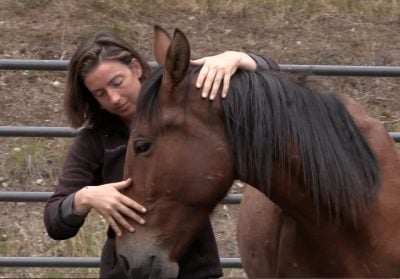
There also seems to be a part of Elsa that is not aware that although she has positioned this film as an exploration of choice, she makes statements like this when describing her first week with Myrnah:
“Our moving together was the thing that we were seeking.”
Really? Myrnah in her first 2 weeks of captivity was seeking to move together with you, as you applied pressure and rewarded her with stillness, because she did what you asked? She actually chose that, rather than eating hay, grazing in the fields, or grooming a herdmate?
Perhaps moving together was the thing that Elsa was seeking. And Myrnah was seeking open rangeland, her missing herd, and beloved family members. Just saying.
The other thing I find interesting is that most of the film footage shows Elsa working alone with Myrnah. In the first few weeks in the corral, there is the one other mustang belonging to her friend, who is usually off to the side, but not interfering or wanting to be with Elsa. And then in the open fields, there are only the 2 of them.
So this is a horse that has never been alone in her life. Rather, she has always been surrounded by her family. And now she has only 1 herd member (Elsa) for fairly long chunks of time each day. Right there, how much choice does Myrnah really have? If she doesn’t get with Elsa, in her mustang experience, she will face isolation/death. So although Elsa is pretty demanding, at least she’s company, and Myrnah’s not alone as predator bait.
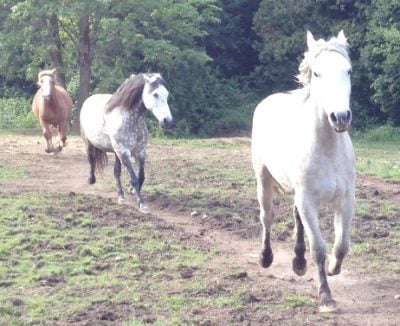
I ask this question because I have been working with 3 semi-feral horses (no tools or food either) within their herd of four horses on 10 acres. I saw a fair amount of resistance/resignation in Myrnah at certain points – where mine would have walked away to graze with a herdmate instead. But Myrnah didn’t have that option.
Please know I’m not suggesting Elsa should have done things differently. I’m merely pointing out that wild horses only exist in herds. So isolating one on their own is putting the horse in an insecure position where she would be strongly motivated to align with a companion or protector – and kind of skews the outcome to the opening question of “what would the horse choose?”
You see the same thing with dogs. When you’re alone with your dog, trekking through wilderness, your dog is right there. Add another dog or two into the mix and your dog now has a variety of fun, intriguing, compelling options open to her. Although your dog will still be connected to you, she now has a lot more choice as to where to place her attention and energy.
Is true choice even possible?
So although I’m questioning the fundamental assertion of this film; that Myrnah was free to choose. I’m not sure it’s even possible for those of us experienced with horses to actually allow an unstructured relationship of complete choice to evolve – with no agenda whatsoever.
Perhaps that could only be done by a newbie with no previous experience or contact with horses whatsoever…
In Taming Wild, we see Elsa coming to Myrnah with a default agenda of training goals, within a pressure/release training paradigm.
So now we’re back to the question of how much choice is really present during manipulative training techniques?
Much as I am drawn to and open to the possibility that true choice could exist, I also feel the pressure of preparing my horses to be functional in captivity. And I too have been unable to bypass that default.
For example, a friend left the gate open once and all 4 horses went exploring down the road. If I hadn’t taught them how to wear halters and walk alongside a human, how would we have got them back home? The fact that our connection (their choice to be with me) is also solid is what allowed me to walk right up to them in their jazzed up state, and halter them, one-by-one.
I also found it interesting that Elsa first trained Myrnah to give to pressure – her hand on the side of Myrnah’s face, or neck, for example – and then trained Myrnah to follow her around at a walk. Whereas I’ve trained mine the exact opposite!
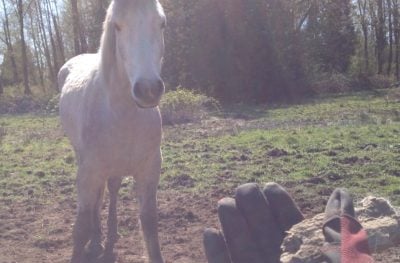
I first taught mine to follow me when I beckoned “come” with my fingers, change direction (left and right), back up, etc. at liberty, using hand gestures. And of course I would follow them too when they asked. After we had established that language, then I added pressure – hand pushing, rope, halter. My reasoning is that although I don’t like to apply pressure, someone else might need to lead them (see aforementioned escape) and in that case, they need to know what the person is asking when they pull on their halter.
All paths lead to Rome.
I have to say, I enjoyed this film so much I do wish it were longer! I’m also curious to see/know what happens with Myrnah’s gorgeous foal… does Elsa train him the same way? And how does he differ (or is similar) from the way Myrnah responded?
I would also be very interested to hear how someone like Ren Hurst would assess this film. Ren has also trained over 100 horses and then gave it all up to just be with her herd on the ground – she no longer rides and believes that no horse actually wants to be ridden. I wonder what Ren’s assessment of Myrnah’s body language and responses would be?
And that’s another important distinction: Between the horse that chooses to allow you to do what you want. And the horse that asks you to get on their back.
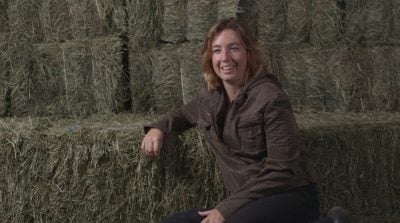
So although the opening question to this film is:
“What if horses were given a choice? Would they carry us on their backs if they really had a choice? Would they want us to ride?”
For me, the film does not answer this question. Instead, it brings up a whole slew of questions about how one defines ‘choice’. What would be the parameters involved in setting up an experiment that would give a wild horse true, complete freedom of choice, as to whether to be with a human, or not?
Does the application of pressure negate choice?
Does manipulation by a captor negate choice?
Does isolation negate choice?
Does trauma (separation from family) negate choice?
But this film is brilliant, intriguing, and so worthwhile for bringing up these questions – for spurring us to become more honest, to dig deeper, to think more critically about our methods and motivations. You can purchase the film here. And in case you missed it, here’s the trailer.
And once again, I come back to the purest example of choice I’ve seen to date: Carolyn Resnick as a child, spending 3 whole summers hanging out with a wild herd, no tools, no food, no fences. And yes, the lead mare, and then several other herd members, invited Carolyn onto their backs – after three years of hanging out.
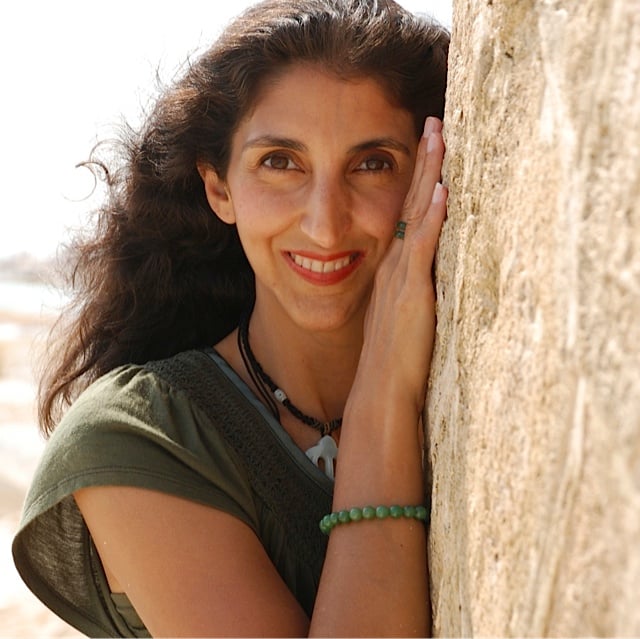
Jini Patel Thompson is a natural health writer and Lazer Tapping instructor. She began riding at age 2 in Kenya, and got her first horse at age 8 in Alberta, and so continues a life-long journey and love affair with these amazing creatures.








Great review and thanks for adding an enlightening angle to the film which I’ve seen.
I think what Elsa has done is provided another angle to contemplate – and to show that tools aren’t necessary to train with if you choose not to use them. Although I do agree that domestic horses need to be used to our tools and pressures to exist safely in our world.
I think you have made some great points about this film and highlighted several things that bothered me also when watching it.
Thanks.
Yes I agree Cynthia – a huge value for this film is showing how you can get lighter and lighter with the natural horsemanship techniques and it still works just fine as a training regime.
This will be an interesting film to view.
Your last paragraph jumped out at me because while I truly do admire Carolyn Resnick and her method, I find myself questioning that she is the purest example of choice. I feel this way because Carolyn has stated that she holds a belief that most horses want to be ridden (this statement was in one of her recent emails as part of her Chair Challenge and it hearkens back to her days in the desert). With a belief like that, would it have been possible for her to be truly objective about reading the horses, particularly at such a young age? Is it possible that it was a projection? Again, I love the first two Waterhole Rituals (saying hello and sharing territory) because they are friendship based and practicing them with my horse helped to transform my relationship with my horse. But if someone holds the belief that horses want to be ridden, is it truly possible for them to be objective about the matter, even someone like Carolyn?
You’re absolutely right Monica and it shows a strong existing bias. Keeping in mind the fact that Carolyn also had riding lessons from a young age, surrounded by Western ranch folk who adhered strongly to the “earn your keep – must have a job” ethos – thus forming or strengthening that bias.
So again, this brings us back into a discussion of “allow” versus “want”. And I think we can also over-simplify the relationship (and make it less vital and fulfilling) by only doing/being/feeling what the horse “wants”.
For example, did I “want” to breastfeed my kids for FIVE YEARS?? Hell no! But I did it because they needed it and I love them. Did I want to carry my babies around in my arms, on my back, or slung around my chest for years? Also no! I have a scoliosis and multiple neck, shoulder and knee injuries. But they loved it! It’s a cornerstone of mother-child bonding and intimate relationship. So when they asked to be carried, I carried them. And I did lots of yoga, craniosacral, body rolling and osteopathic work to take care of my body’s needs, repair any damage, and prevent any suffering on my part.
So if I have a horse, who out of love and deep connection with me, allows me to ride on her back. And I get off the minute I’m asked (because I trust that she knows her body’s limits better than me), and I sit wherever on her back she signals me to sit – not where it’s most comfortable or least precarious for me – and we both enjoy the profound fusion of 2 bodies that can occur while riding in motion and freedom (just like me with my children)… and she receives regular chiropractic, reiki, massage, etc. to take care of her body’s needs… is that coercive, abusive, or otherwise a problem?
Here’s what happened a few days ago when my 13-year-old daughter Zara was out with the horses on her own – removing manure from the fields with a friend of hers. Keep in mind that my daughter has ridden very little and when she was 11 stated quite categorically (about a retired mare we had) that “It doesn’t matter whether I ride or not, I just love being with her and watching her… I don’t want to ride a lot of the time anyway.” Zara said that all of the horses came up to her and gave her kisses. And Audelina (Belgian mare) followed her around the entire time, giving her kisses and hugs (she puts her head over Zara’s torso and hugs her into her chest). Then when they were finished scooping and waiting for me, she was standing on the slow feeder and Audelina came up to her for kisses, then swung round so she was parallel, and then moved closer until she was pressing against Zara’s legs.
Keep in mind that 1 year ago, Audelina was a malnourished, semi-feral horse. Zara knows I have not sat on her back yet. And Zara is very cautious about her safety, she is not reckless or adventurous – she is a gymnast and guards her body against injury, especially during competition/performance season! In Zara’s words: “She kept asking me to get on her back, so finally I did and I lay across her back (she laid with her belly against Aude’s back and her head and feet pointing to the ground). Aude sighed and went ‘brrrrrrr’ with her lips and then she hugged me through her back!”
It’s an interesting journey for sure!
Well … I say this respectfully … having children is a choice and a woman can inform herself (ask questions, do research) to educate herself of the potential wear and tear pregnancy and child rearing may have and consciously decide to take those risks and make those sacrifices. A horse cannot go the library and read a book about the risks of carrying a human on its back. So then it becomes a question of informed consent.
I am taking a course right now and we are discussing the domestication of women and how often we want things (marriage, careers, homes, handbags) because we have been conditioned into thinking we want them, so our seemingly freely made choices aren’t authentic at all. It’s an interesting conversation and I am beginning to notice the parallels between our domestication and the domestication of horses. Still mulling it around but it is definitely an interesting train of thought.
I saw a study once where 74% of parents polled said, if they had to make the decision again (from scratch) they would choose not to have children. I totally agree with people becoming very aware of what it means to nurture children and to make a researched decision about that. In fact, I wrote an article about this very topic! http://blog.listentoyourgut.com/should-i-have-a-baby/
Yes yes yes
Oh wow – I’m so glad I found this! For the past few years I’ve been wondering if/where there were people who think like I do about horses. A month or two ago I learned about Elsa’s movie for the first time, and I was planning to buy it today, but I wanted to see a review first… and anyway, that’s how I found your article, Jini. And I’m so impressed by your thoughtfulness and insight! I’m just so, SO glad I found this.
I’ve been teaching horseback riding to earn money for years. I figured, since I had learned (and was still learning) so much about it that I could get some cash for teaching others what I knew. But then I started to realize that what I had been taught – and what I was teaching – didn’t really jive with what I really wanted. What I wanted was friendship with horses. What I was doing looked more like semi-gentle enslavement.
I’m getting off on an all-about-me tangent. Sorry about that. Anyway, I’ve been searching for better ways to be with horses for a couple of years now, and have started teaching beginners how to ride and work with horses in a much gentler way. But I want to learn more – I really think I could still improve so much, and become even better for the horses.
I would really appreciate any advice you might have. I’ve opened up links already to your Ren Hurst article – I’ve actually never heard of Ren Hurst, so I’m eager to find out more about her and learn what I can there. And I’m planning to read about Carolyn Resnick too. Any other recommendations?
Hi Stephanie, so great to hear from you! And please, write MORE about yourself and your journey – it is so interesting!
I think the books that have made the biggest impact on me for the area you’re talking about are:
Empowered Horses by Imke Spilker
Horses A Better Way by Maureen Tierney
Beyond the Dream Horse by Michael Bevilacqua (please god, someone get him a good editor, but the concepts are there) 🙂
Zen and Horseback Riding by Tom Nagel
and Ren Hurst’s book, Riding On The Power Of Others along with Carolyn Resnick’s Naked Liberty
Definitely get the Taming Wild film and also watch Emma Massingale’s No Reins, No Rules, No Limits – both of these trainers are still using pressure/release tactics but in the gentlest ways possible and Emma allows for a lot of collaboration and input of the horses ideas into the training:
https://www.listentoyourhorse.com/video-emma-massingale-liberty-equine-adventures/
And have a read here:
https://www.listentoyourhorse.com/true-mutuality-choosing-to-ride/
https://www.listentoyourhorse.com/the-tangled-conundrum-of-consensual-riding/
https://www.listentoyourhorse.com/do-horses-really-enjoy-working-with-us/
https://www.listentoyourhorse.com/5-minute-fun-equine-collaborative-learning-method/
https://www.listentoyourhorse.com/manipulating-your-horse-making-your-idea-his-idea/
https://www.listentoyourhorse.com/healing-through-riding/
https://www.listentoyourhorse.com/intimacy-with-a-horse-involves-choice/
I would LOVE to hear how your thoughts and methods evolve as you learn and explore this new, gentler way – please stay in touch!
Hi Jini,
Thank you so much for the great review, the fabulous reading list and all the links to past blog posts. So enjoy your blog!
Oh thank you so much K! Just took a peek at your blog and your story looks so interesting – haven’t started reading yet, but I will! Although I have to say, the thought that came immediately to mind is that I would love to have it as a book, with photos (even b/w photos give a nice feel). When you’re finished writing all the posts about it, you could compile the best parts of them into a book. And self-publishing is so easy and cheap these days:
http://brainstormyourbiz.com/business/the-easy-way-to-write-and-publish-a-book/
If you do this, be sure to tag me here or email me and I will be your first customer! Oh one more thing about your blog – bigger pictures please!
For others who are reading, here is KBoone’s blog:
http://ridingacrossspain.com
Omg, yes, I could not have written that better myself.. you nailed it, and I saw the taming wild stallions in nambia and that gave me the same and more questions…..it has caused me to think a lot….I have a three herds totaling 20 horses plus other critters….this summer I took a wild soul woman course….and then I read Alexander nevzoroz…I have more questions about myself and my horses than ever and do not have the answers yet….a strange and yet magical place to be….
Hi Heather, I found that Namibia film on Vimeo here:
https://vimeo.com/33062665
But I hit 24 minutes, where she puts the halter on him and starts pulling on his face – after he’s shown incredible faith and trust in her – and I just couldn’t watch anymore. Maybe at a later time. But honestly, I’m just so sick of people using animals solely for their own agenda. It’s always about, “Look what I can make this horse do!” Honestly, oh great, yet another domineering human, how unique… NOT.
I would have liked to see her carry on relationship-building; where she perceives a need or desire of his and (because she’s more powerful and in charge) provides it. Like when she poured water out to make him a mud pit. And then brought him fresh greens to eat. Why can’t the relationship and exploration continue in that mutually-beneficial, unhurried way. Oh right, because we’re humans and we just don’t have time for that.
Anyhoo – I MUCH more enjoyed having a browse round your site! Wish your pictures were bigger though, so I could get a better look at your gorgeous Friesians 🙂
I’m pretty sure there’s a Friesian in my future – probably after I find my land. Sounds like you’re headed in a great direction though and you have such a full foundation/background to build upon. I’m sure your journey’s an interesting one.